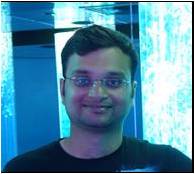2016 New Investigator: Soumik Siddhanta

 Nominee:
Nominee:
Nominated By:
Supporting Comments:
What made you choose a career in bioanalysis?
Coming from a developing nation like India, which has one of the largest instances of deaths due to chronic diseases, I developed the interest to develop a single and universal, fast, accurate and low-cost method for screening of small molecule drug targets in order to discover more efficient drugs. My background in chemistry, material science and spectroscopy has further refined the direction of my research. The journey in this interdisciplinary field has been exciting so far with the prospect of working with considerable freedom on developing this simple yet powerful spectroscopy based screening technique which can be used without sophisticated instrumentation and sample preparation methods. I continue my pursuits and hope to see the outcomes translated to commercial settings.
Describe the main highlights of your bioanalytical research, and its importance to the bioanalytical community.
My aim is to develop a simple analytical technique which can serve as a screening tool and can be universally applied to a wide range of biomolecules. Optics and spectroscopy based detection of molecular signatures have enabled us to devise such platforms. I have found that the emerging area of surface enhanced Raman spectroscopy (SERS) is suitable for exploring a vast arrays of molecular markers of diseases.
My research has been focused on accessing the fundamental vibrational fingerprints of molecules such as proteins without any a-priori knowledge of their structure and understanding molecular interactions in a label-free manner. Traditional techniques like X-ray crystallography and NMR relies upon elaborate sample preparation techniques and instrumentation and hence are not convenient for high throughput screening of small molecule drug targets. Therefore, in order to address this unmet need, we have introduced this SERS based spectroscopic tool in conjunction with molecular simulations, data processing algorithms and computational techniques to provide basic understanding of small molecule- protein interactions, which forms the cornerstone for drug discovery.
My recent publication in PNAS has been impactful in demonstrating the high efficacy of this technique in predicting the binding locations of drugs on protein pockets at ultra-low concentrations, in physiological conditions and requiring minimum and low cost instrumentation. Finally, my recent work aims to translate this technique to in-vivo and in intracellular settings, which brightens the prospect for real-time monitoring of efficacy of drug molecules.
What is the impact of your work beyond your home laboratory?
I envision that my work on harnessing SERS for studying biomolecular interactions have tremendous technological implications. The development of new and efficient drug molecules is a multi-billion-dollar industry and often depend upon an array of techniques to find new targets. Most of the experimental techniques already available commercially require a high protein concentration or incorporation of secondary tag molecules, which increases the cost significantly.
Our SERS based technique offers the solution to these problems by requiring minimal volume of samples as well as concentration. The low signal acquisition times and the absence of specialized sample preparation techniques makes it time and cost efficient. These attributes make this technique suitable for applications in large scale in commercial setup.
The steady increase in the citations of our papers is indeed a positive marker and this technique has been taken up by various research groups across the world, which will also provide validation across different proteins and drug targets.
Describe the most difficult challenge you have encountered in the laboratory and how you overcame it.
SERS works on the principle of enhancement of Raman scattering in the vicinity of nanostructured plasmonic materials which exhibits surface plasmon resonance when they interact with light to provide areas of intense electromagnetic field known as “hotspots”. Controlling these hotspots at nanometer scale is indeed a challenge and often leads to poor reproducibility.
In order to alleviate these issues and achieve nanoscale controllability, I designed and fabricated hybrid plasmonic substrates using sophisticated techniques such as molecular beam epitaxy to achieve high reproducibility and sensitivity of the SERS signals.
Another challenge was to retain the structure of the protein and prevent its denaturation in the presence of these nanostructures. I devised a method based on the exceptional protein stabilizing property of trehalose to overcome this problem while recording SERS spectra. Even after these problems were tackled successfully, it was really a challenge to gain an understanding and assign the SERS modes of bulky molecules like proteins, and the associated changes on binding of small molecules, which had to be extensively correlated with protein-molecule
complexes simulated from the available protein structures from the protein database.
Describe your role in bioanalytical communities/groups.
I have presented my work on using SERS to study biomolecular interactions in various international conferences. The top 5 conferences I have attended are given below:
- International Union of Materials Research Society, International Conference in Asia – 2013, December 16-20, 2013, Bangalore,
India. - 7th international conference on materials for advanced technologies, Singapore (ICMAT, June 30- July 5, 2013).
- 5th Bangalore Nano, December 5-7, 2012, Bangalore, India.
- 23rd international conference on Raman spectroscopy, Indian Institute of Science, Bangalore, India. (August 12 – 17, 2012).
- International Conference on Contemporary Trends in Optics and Optoelectronics, January, 2011, Thiruvananthapuram, India.
Please list up to five of your publications in the field of bioanalysis:
- Karthigeyan D,* Siddhanta S,* Kishore AH,* Perumal SSRR , Aren H, Sudevan S, Bhat AV, Balasubramanyam K, Subbegowda RK, Kundu TK. Narayana C. SERS and MD simulation studies of a kinase inhibitor demonstrate the emergence of a potential drug discovery tool. Proceedings of the National Academy of Sciences. 111(29), 10416–10421 (2014). (*Equal contribution).
- Mettela G ,*Siddhanta S,* Narayana C, Kulkarni GU. Nanocrystalline Ag microowers as a versatile SERS platform. Nanoscale. 6, 7480–7488 (2014). (*Equal contribution).
- Siddhanta S, Karthigeyan D, Kundu PP, Kundu TK , Narayana C.Surface enhanced Raman spectroscopy of Aurora kinases: direct, ultrasensitive detection of autophosphorylation. RSC Advances. 3(13), 4221–4230 (2013).
- Siddhanta S, Wrobel MS, Barman I. Integration of protein tethering in a rapid and label-free SERS screening platform for drugs of abuse. Chemical Communications doi: 10.1039/C6CC00518G (2016) (Epub ahead of print).
- Paidi SK, Siddhanta S, Strouse RJ , McGivney JB, Larkin C, Barman I. Rapid Identification of Biotherapeutics with Label-Free Raman Spectroscopy. Analytical Chemistry.88(8), 4361–4368 (2016).
Please select one publication from above that best highlights your career to date in the field of bioanalysis and provide an explanation for your choice.
Karthigeyan D,* Siddhanta S,* Kishore AH,* Perumal SSRR , Aren H, Sudevan S, Bhat AV, Balasubramanyam K, Subbegowda RK, Kundu TK. Narayana C. SERS and MD simulation studies of a kinase inhibitor demonstrate the emergence of a potential drug discovery tool. Proceedings of the National Academy of Sciences. 111(29), 10416–10421 (2014). (*Equal contribution).
This work highlights the combined usage of SERS along with molecular dynamics simulation for understanding drug binding to therapeutic proteins. It demonstrates the emergence of a new powerful technique and a robust approach for drug discovery. This label-free technique can also be potentially translated to other molecular detection platforms for targeted or direct detection of biomolecular interactions.



